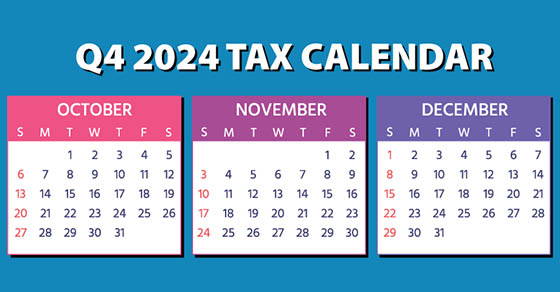Weekly Tax Brief
You don’t have to be in business to deduct certain vehicle expenses
- Details
- Published: 31 October 2024 31 October 2024

When you think about tax deductions for vehicle-related expenses, business driving may come to mind. However, businesses aren’t the only taxpayers that can deduct driving expenses on their returns. Individuals may also be able to deduct them in certain circumstances. Unfortunately, under current law, you may be unable to deduct as much as you could years ago.
How the TCJA changed deductions
For years before 2018, miles driven for business, moving, medical and charitable purposes were potentially deductible. For 2018 through 2025, business and moving miles are deductible only in much more limited circumstances. The changes resulted from the Tax Cuts and Jobs Act (TCJA), which could also affect your tax benefit from medical and charitable miles.
Before 2018, if you were an employee, you potentially could deduct business mileage not reimbursed by your employer as a miscellaneous itemized deduction. The deduction was subject to a 2% of adjusted gross income (AGI) floor, meaning that mileage was deductible only to the extent that your total miscellaneous itemized deductions for the year exceeded 2% of your AGI. However, for 2018 through 2025, you can’t deduct the mileage regardless of your AGI. Why? The TCJA suspends all miscellaneous itemized deductions subject to the 2% floor.
If you’re self-employed, business mileage can still be deducted from self-employment income. It’s not subject to the 2% floor and is still deductible for 2018 through 2025, as long as it otherwise qualifies.
Medical and moving
Miles driven for a work-related move before 2018 were generally deductible “above the line” (itemizing wasn’t required to claim the deduction). However, for 2018 through 2025, under the TCJA, moving expenses are deductible only for active-duty military members.
If you itemize, miles driven for health-care-related purposes are deductible as part of the medical expense deduction. For example, you can include in medical expenses the amounts paid when you use a car to travel to doctors’ appointments. For 2024, medical expenses are deductible to the extent they exceed 7.5% of your AGI.
The limits for deducting expenses for charitable miles driven are set by law and don’t change yearly based on inflation. But keep in mind that the charitable driving deduction can only be claimed if you itemize. For 2018 through 2025, the standard deduction has nearly doubled, so not as many taxpayers are itemizing. Depending on your total itemized deductions, you might be better off claiming the standard deduction, in which case you’ll get no tax benefit from your charitable miles (or from your medical miles, even if you exceed the AGI floor).
Rates depend on the trip
Rather than keeping track of your actual vehicle expenses, you can use a standard mileage rate to compute your deductions. The 2024 rates vary depending on the purpose:
- Business, 67 cents per mile.
- Medical, 21 cents per mile.
- Moving for active-duty military, 21 cents per mile.
- Charitable, 14 cents per mile.
In addition to deductions based on the standard mileage rate, you may deduct related parking fees and tolls. There are also substantiation requirements, which include tracking miles driven.
We can answer any questions
Do you have questions about deducting vehicle-related expenses? Contact us. We can help you with your tax planning.
© 2024
How can you build a golden nest egg if you’re self-employed?
- Details
- Published: 30 October 2024 30 October 2024

If you own a small business with no employees (other than your spouse) and want to set up a retirement plan, consider a solo 401(k) plan. This is also an option for self-employed individuals or business owners who wish to upgrade from a SIMPLE IRA or Simplified Employee Pension (SEP) plan.
A solo 401(k), also known as an individual 401(k), may offer advantages in terms of contributions, tax savings and investment options. These accounts are geared toward self-employed individuals, including sole proprietors, owners of single-member limited liability companies, consultants and other one-person businesses.
How much can you contribute?
You can make large annual tax-deductible contributions to a solo 401(k) plan. For 2024, you can make an “elective deferral contribution” of up to $23,000 of your net self-employment (SE) income to a solo 401(k). The elective deferral contribution limit increases to $30,500 if you’ll be age 50 or older as of December 31, 2024. The larger $30,500 figure includes an extra $7,500 catch-up contribution that’s allowed for older owners.
On top of your elective deferral contribution, an additional contribution of up to 20% of your net SE income is permitted for a solo 401(k). This is called an “employer contribution,” though there’s technically no employer when you’re self-employed. For purposes of calculating the employer contribution, your net SE income isn’t reduced by your elective deferral contribution.
For the 2024 tax year, the combined elective deferral and employer contributions can’t exceed:
- $69,000 ($76,500 if you’ll be 50 or older as of December 31, 2024), or
- 100% of your net SE income.
Net SE income equals the net profit shown on Form 1040, Schedule C, E or F for the business, minus the deduction for 50% of self-employment tax attributable to the business.
What are the advantages and disadvantages?
Besides the ability to make significant deductible contributions, another solo 401(k) advantage is that contributions are discretionary. If cash is tight, you can contribute a small amount or nothing.
In addition, you can borrow from your solo 401(k) account, assuming the plan document permits it. The maximum loan amount is 50% of the account balance or $50,000, whichever is less. Some other plan options, including SEPs, don’t allow loans. This feature can be valuable if you need access to funds for business opportunities or emergencies.
The biggest downside to solo 401(k)s is their administrative complexity. Significant upfront paperwork and ongoing administrative efforts are required, including adopting a written plan document and arranging how and when elective deferral contributions will be collected and paid into the owner’s account. Also, once your account balance exceeds $250,000, you must file Form 5500-EZ with the IRS annually.
You can’t have a solo 401(k) if your business has one or more employees. Instead, you must have a multi-participant 401(k) with all the resulting complications. The tax rules may require you to make contributions for those employees. However, there are a few important loopholes. You can contribute to a plan if your spouse is a part-time or full-time employee. You can also exclude employees who are under 21 and part-time employees who haven’t worked at least 1,000 hours during any 12-month period.
Who’s the best candidate for this plan?
For a one-person business, a solo 401(k) can be a smart retirement plan choice if:
- You want to make large annual deductible contributions and have the money,
- You have substantial net SE income, and
- You’re 50 or older and can take advantage of the extra catch-up contribution.
Before establishing a solo 401(k), weigh the pros and cons of other retirement plans — especially if you’re 50 or older. Solo 401(k)s aren’t simple, but they can allow you to make substantial and deductible contributions to a retirement nest egg. Contact us before signing up to determine what’s best for your situation.
© 2024
Employers: In 2025, the Social Security wage base is going up
- Details
- Published: 22 October 2024 22 October 2024

As we approach 2025, changes are coming to the Social Security wage base. The Social Security Administration recently announced that the wage base for computing Social Security tax will increase to $176,100 for 2025 (up from $168,600 for 2024). Wages and self-employment income above this amount aren’t subject to Social Security tax.
If your business has employees, you may need to budget for additional payroll costs, especially if you have many high earners.
Social Security basics
The Federal Insurance Contributions Act (FICA) imposes two taxes on employers, employees and self-employed workers. One is for Old Age, Survivors and Disability Insurance, which is commonly known as the Social Security tax, and the other is for Hospital Insurance, which is commonly known as the Medicare tax.
A maximum amount of compensation is subject to the Social Security tax, but there’s no maximum for Medicare tax. For 2025, the FICA tax rate for employers will be 7.65% — 6.2% for Social Security and 1.45% for Medicare (the same as in 2024).
Updates for 2025
For 2025, an employee will pay:
- 6.2% Social Security tax on the first $176,100 of wages (6.2% × $176,100 makes the maximum tax $10,918.20), plus
- 1.45% Medicare tax on the first $200,000 of wages ($250,000 for joint returns, $125,000 for married taxpayers filing separate returns), plus
- 2.35% Medicare tax (regular 1.45% Medicare tax plus 0.9% additional Medicare tax) on all wages in excess of $200,000 ($250,000 for joint returns, $125,000 for married taxpayers filing separate returns).
For 2025, the self-employment tax imposed on self-employed people will be:
- 12.4% Social Security tax on the first $176,100 of self-employment income, for a maximum tax of $21,836.40 (12.4% × $176,100), plus
- 2.90% Medicare tax on the first $200,000 of self-employment income ($250,000 of combined self-employment income on a joint return, $125,000 on a return of a married individual filing separately), plus
- 3.8% (2.90% regular Medicare tax plus 0.9% additional Medicare tax) on all self-employment income in excess of $200,000 ($250,000 of combined self-employment income on a joint return, $125,000 for married taxpayers filing separate returns).
History of the wage base
When the government introduced the Social Security payroll tax in 1937, the wage base was $3,000. It remained that amount through 1950. As the U.S. economy grew and wages began to rise, the wage base needed to be adjusted to ensure that the Social Security system continued to collect sufficient revenue. By 1980, it had risen to $25,900. Twenty years later it had increased to $76,200 and by 2020, it was $137,700. Inflation and wage growth were key factors in these adjustments.
Employees with more than one employer
You may have questions about employees who work for your business and have second jobs. Those employees would have taxes withheld from two different employers. Can the employees ask you to stop withholding Social Security tax once they reach the wage base threshold? The answer is no. Each employer must withhold Social Security taxes from an employee’s wages, even if the combined withholding exceeds the maximum amount that can be imposed for the year. Fortunately, the employees will get a credit on their tax returns for any excess withheld.
Looking ahead
Do you have questions about payroll tax filing or payments now or in 2025? Contact us. We’ll help ensure you stay in compliance.
© 2024
How your business can prepare for and respond to an IRS audit
- Details
- Published: 14 October 2024 14 October 2024

The IRS has been increasing its audit efforts, focusing on large businesses and high-income individuals. By 2026, it plans to nearly triple its audit rates for large corporations with assets exceeding $250 million. Under these plans, partnerships with assets over $10 million will also see audit rates increase tenfold by 2026. This ramp-up in audits is part of the IRS’s broader strategy, funded by the Inflation Reduction Act, to target wealthier entities and high-dollar noncompliance.
The IRS doesn’t plan to increase audits for individuals making less than $400,000 annually. Small businesses are also unlikely to see a rise in audit rates in the near future, as the IRS is prioritizing more complex returns for higher-wealth entities. For example, the tax agency has announced that one focus area is taxpayers who personally use business aircraft. A business can deduct the cost of purchasing and using corporate planes, but personal trips, including vacation travel, aren’t deductible.
Preparation is key
The best way to survive an IRS audit is to prepare in advance. On an ongoing basis, you should systematically maintain documentation — invoices, bills, canceled checks, receipts, or other proof — for all items to be reported on your tax returns. Keep all records in one place.
It also helps to know what might catch the attention of the IRS. Certain types of tax return entries are known to involve inaccuracies, so they may lead to an audit. Some examples include:
- Significant inconsistencies between tax returns filed in the past and your most current return,
- Gross profit margin or expenses markedly different from those of other businesses in your industry, and
- Miscalculated or unusually high deductions.
The IRS may question specific deductions because there are strict recordkeeping requirements associated with them — for example, auto and travel expense deductions. In addition, an owner-employee’s salary that’s much higher or lower than those at similar companies in his or her location may catch the IRS’s eye, especially if the business is structured as a corporation.
How to respond to an audit
If the IRS selects you for an audit, it will notify you by letter. Generally, the IRS doesn’t make initial contact by phone. But if there’s no response to the letter, the agency may follow up with a call.
Many audits simply request that you mail in receipts or other documentation to support certain deductions you’ve claimed. Only the strictest version, the field audit, requires a meeting with one or more IRS auditors. (Note: Ignore unsolicited emails or text messages about an audit. The IRS doesn’t contact people in this manner. These are scams.)
The tax agency doesn’t demand an immediate response to a mailed notice. The IRS will inform you of the discrepancies in question and give you time to prepare. Collect and organize all relevant income and expense records. If anything is missing, you’ll have to reconstruct the information as accurately as possible based on other documentation.
If you’re audited, our firm can help you:
- Understand what the IRS is disputing (it’s not always clear),
- Gather the specific documents and information needed, and
- Respond to the auditor’s inquiries in the most effective manner.
The IRS usually has three years to conduct an audit, and it probably won’t begin until a year or more after you file a return. Stay calm if the IRS contacts you. Many audits are routine. By taking a meticulous, proactive approach to tracking, documenting and filing your company’s tax-related information, you’ll make an audit more manageable. It may even decrease the chances you’ll be chosen in the first place.
© 2024
Advantages of keeping your business separate from its real estate
- Details
- Published: 11 October 2024 11 October 2024

Does your business require real estate for its operations? Or do you hold property titled under your business’s name? It might be worth reconsidering this strategy. With long-term tax, liability and estate planning advantages, separating real estate ownership from the business may be a wise choice.
How taxes affect a sale
Businesses that are formed as C corporations treat real estate assets as they do equipment, inventory and other business assets. Any expenses related to owning the assets appear as ordinary expenses on their income statements and are generally tax deductible in the year they’re incurred.
However, when the business sells the real estate, the profits are taxed twice — at the corporate level and at the owner’s individual level when a distribution is made. Double taxation is avoidable, though. If ownership of the real estate is transferred to a pass-through entity instead, the profit upon sale will be taxed only at the individual level.
Safeguarding assets
Separating your business ownership from its real estate also provides an effective way to protect the real estate from creditors and other claimants. For example, if your business is sued and found liable, a plaintiff may go after all of its assets, including real estate held in its name. But plaintiffs can’t touch property owned by another entity.
The strategy also can pay off if your business is forced to file for bankruptcy. Creditors generally can’t recover real estate owned separately unless it’s been pledged as collateral for credit taken out by the business.
Estate planning implications
Separating real estate from a business may give you some estate planning options, too. For example, if the company is a family business but all members of the next generation aren’t interested in actively participating, separating property gives you an extra asset to distribute. You could bequest the business to one member and the real estate to another.
Handling the transaction
If you’re interested in this strategy, the business can transfer ownership of the real estate and then the transferee can lease it back to the company. Who should own the real estate? One option: The business owner can purchase the real estate from the business and hold title in his or her name. One concern though, is that it’s not only the property that’ll transfer to the owner but also any liabilities related to it.
In addition, any liability related to the property itself may inadvertently put the business at risk. If, for example, a client suffers an injury on the property and a lawsuit ensues, the property owner’s other assets (including the interest in the business) could be in jeopardy.
An alternative is to transfer the property to a separate legal entity formed to hold the title, typically a limited liability company (LLC) or limited liability partnership (LLP). With a pass-through structure, any expenses related to the real estate will flow through to your individual tax return and offset the rental income.
An LLC is more commonly used to transfer real estate. It’s simple to set up and requires only one member. LLPs require at least two partners and aren’t permitted in every state. Some states restrict them to certain types of businesses and impose other restrictions.
Tread carefully
It isn’t always advisable to separate the ownership of a business from its real estate. If it’s a valuable move, the right approach will depend on your individual circumstances. Contact us to help determine the best way to minimize your transfer costs and capital gains taxes while maximizing other potential benefits.
© 2024
2024 Q4 tax calendar: Key deadlines for businesses and other employers
- Details
- Published: 24 September 2024 24 September 2024

Here are some of the key tax-related deadlines affecting businesses and other employers during the fourth quarter of 2024. Keep in mind that this list isn’t all-inclusive, so there may be additional deadlines that apply to you. Contact us to ensure you’re meeting all applicable deadlines and to learn more about the filing requirements.
Note: Certain tax-filing and tax-payment deadlines may be postponed for taxpayers who reside in or have a business in a federally declared disaster area.
Tuesday, October 1
- The last day you can initially set up a SIMPLE IRA plan, provided you (or any predecessor employer) didn’t previously maintain a SIMPLE IRA plan. If you’re a new employer that comes into existence after October 1 of the year, you can establish a SIMPLE IRA plan as soon as administratively feasible after your business comes into existence.
Tuesday, October 15
- If a calendar-year C corporation that filed an automatic six-month extension:
- File a 2023 income tax return (Form 1120) and pay any tax, interest and penalties due.
- Make contributions for 2023 to certain employer-sponsored retirement plans.
Thursday, October 31
- Report income tax withholding and FICA taxes for third quarter 2024 (Form 941) and pay any tax due. (See exception below under “November 12.”)
Tuesday, November 12
- Report income tax withholding and FICA taxes for third quarter 2024 (Form 941), if you deposited on time (and in full) all the associated taxes due.
Monday, December 16
- If a calendar-year C corporation, pay the fourth installment of 2024 estimated income taxes.
Contact us if you’d like more information about the filing requirements and to ensure you’re meeting all applicable deadlines.
© 2024
Is your home office a tax haven? Here are the rules for deductions
- Details
- Published: 19 September 2024 19 September 2024

Working from home has become increasingly common. The U.S. Bureau of Labor Statistics (BLS) reports that about one out of five workers conducts business from home for pay. The numbers are even higher in certain occupational groups. About one in three people in management, professional and related occupations works from home.
Your status matters
If you work from a home office, you probably want to know: Can I get a tax deduction for the related expenses? It depends on whether you’re employed or in business for yourself.
Business owners working from home or entrepreneurs with home-based side gigs may qualify for valuable home office deductions. Conversely, employees can’t deduct home office expenses under current federal tax law.
To qualify for a deduction, you must use at least part of your home regularly and exclusively as either:
- Your principal place of business, or
- A place where you meet with customers, clients or patients in the ordinary course of business.
In addition, you may be able to claim deductions for maintaining a separate structure — such as a garage — where you store products or tools used solely for business purposes.
Notably, “regular and exclusive” use means consistently using a specific, identifiable area in your home for business. However, incidental or occasional personal use won’t necessarily disqualify you.
The reason employees are treated differently
Why don’t people who work remotely from home as employees get tax deductions right now? Previously, people who itemized deductions could claim home office expenses as miscellaneous deductions if the arrangement was for the convenience of their employers.
However, the Tax Cuts and Jobs Act suspended miscellaneous expense deductions for 2018 through 2025. So, employees currently get no tax benefit if they work from home. On the other hand, self-employed individuals still may qualify if they meet the tax law requirements.
Expenses can be direct or indirect
If you qualify, you can write off the total amount of your direct expenses and a proportionate amount of your indirect expenses based on the percentage of business use of your home.
Indirect expenses include:
- Mortgage interest,
- Property taxes,
- Utilities (electric, gas and water),
- Insurance,
- Exterior repairs and maintenance, and
- Depreciation or rent under IRS tables.
Note: Mortgage interest and property taxes may already be deductible if you itemize deductions. If you claim a portion of these expenses as home office expenses, the remainder is deductible on your personal tax return. But you can’t deduct the same amount twice — once as a home office expense and again as a personal deduction.
Figuring the deduction
Typically, the percentage of business use is determined by the square footage of your home office. For instance, if you have a 3,000 square-foot home and use a room with 300 square feet as your office, the applicable percentage is 10%. Alternatively, you may use any other reasonable method for determining this percentage, such as a percentage based on the number of comparably sized rooms in the home.
A simpler method
Keeping track of indirect expenses is time-consuming. Some taxpayers prefer to take advantage of a simplified method of deducting home office expenses. Instead of deducting actual expenses, you can claim a deduction equal to $5 per square foot for the area used as an office, up to a maximum of $1,500 for the year. Although this method takes less time than tracking actual expenses, it generally results in a significantly lower deduction.
The implications of a home sale
Keep in mind that if you claim home office deductions, you may be in for a tax surprise when you sell your home.
If you eventually sell your principal residence, you may qualify for a tax exclusion of up to $250,000 of gain for single filers ($500,000 for married couples who file jointly). But you must recapture the depreciation attributable to a home office after May 6, 1997.
Don’t hesitate to contact us. We can address questions about writing off home office expenses and the tax implications when you sell your home.
Help ensure your partnership or LLC complies with tax law
- Details
- Published: 18 September 2024 18 September 2024

When drafting partnership and LLC operating agreements, various tax issues must be addressed. This is also true of multi-member LLCs that are treated as partnerships for tax purposes. Here are some critical issues to include in your agreement so your business remains in compliance with federal tax law.
Identify and describe guaranteed payments to partners
For income tax purposes, a guaranteed payment is one made by a partnership that’s: 1) to the partner acting in the capacity of a partner, 2) in exchange for services performed for the partnership or for the use of capital by the partnership, and 3) not dependent on partnership income.
Because special income tax rules apply to guaranteed payments, they should be identified and described in a partnership agreement. For instance:
- The partnership generally deducts guaranteed payments under its accounting method at the time they’re paid or accrued.
- If an individual partner receives a guaranteed payment, it’s treated as ordinary income — currently subject to a maximum income tax rate of 37%. The recipient partner must recognize a guaranteed payment as income in the partner’s tax year that includes the end of the partnership tax year in which the partnership deducted the payment. This is true even if the partner doesn’t receive the payment until after the end of his or her tax year.
Account for the tax basis from partnership liabilities
Under the partnership income taxation regime, a partner receives additional tax basis in his or her partnership interest from that partner’s share of the entity’s liabilities. This is a significant tax advantage because it allows a partner to deduct passed-through losses in excess of the partner’s actual investment in the partnership interest (subject to various income tax limitations such as the passive loss rules).
Different rules apply to recourse and nonrecourse liabilities to determine a partner’s share of the entity’s liabilities. Provisions in the partnership agreement can affect the classification of partnership liabilities as recourse or nonrecourse. It’s important to take this fact into account when drafting a partnership agreement.
Clarify how payments to retired partners are classified
Special income tax rules also apply to payments made in liquidation of a retired partner’s interest in a partnership. This includes any partner who exited the partnership for any reason.
In general, payments made in exchange for the retired partner’s share of partnership property are treated as ordinary partnership distributions. To the extent these payments exceed the partner’s tax basis in the partnership interest, the excess triggers taxable gain for the recipient partner.
All other payments made in liquidating a retired partner’s interest are either: 1) guaranteed payments if the amounts don’t depend on partnership income, or 2) ordinary distributive shares of partnership income if the amounts do depend on partnership income. These payments are generally subject to self-employment tax.
The partnership agreement should clarify how payments to retired partners are classified so the proper tax rules can be applied by both the partnership and recipient retired partners.
Consider other partnership agreement provisions
Since your partnership may have multiple partners, various issues can come into play. You’ll need a carefully drafted partnership agreement to handle potential issues even if you don’t expect them to arise. For instance, you may want to include:
- A partnership interest buy-sell agreement to cover partner exits.
- A noncompete agreement.
- How the partnership will handle the divorce, bankruptcy, or death of a partner. For instance, will the partnership buy out an interest that’s acquired by a partner’s ex-spouse in a divorce proceeding or inherited after a partner’s death? If so, how will the buyout payments be calculated and when will they be paid?
Minimize potential liabilities
Tax issues must be addressed when putting together a partnership deal. Contact us to be involved in the process.
© 2024
Help ensure your partnership or LLC complies with tax law
- Details
- Published: 18 September 2024 18 September 2024

When drafting partnership and LLC operating agreements, various tax issues must be addressed. This is also true of multi-member LLCs that are treated as partnerships for tax purposes. Here are some critical issues to include in your agreement so your business remains in compliance with federal tax law.
Identify and describe guaranteed payments to partners
For income tax purposes, a guaranteed payment is one made by a partnership that’s: 1) to the partner acting in the capacity of a partner, 2) in exchange for services performed for the partnership or for the use of capital by the partnership, and 3) not dependent on partnership income.
Because special income tax rules apply to guaranteed payments, they should be identified and described in a partnership agreement. For instance:
- The partnership generally deducts guaranteed payments under its accounting method at the time they’re paid or accrued.
- If an individual partner receives a guaranteed payment, it’s treated as ordinary income — currently subject to a maximum income tax rate of 37%. The recipient partner must recognize a guaranteed payment as income in the partner’s tax year that includes the end of the partnership tax year in which the partnership deducted the payment. This is true even if the partner doesn’t receive the payment until after the end of his or her tax year.
Account for the tax basis from partnership liabilities
Under the partnership income taxation regime, a partner receives additional tax basis in his or her partnership interest from that partner’s share of the entity’s liabilities. This is a significant tax advantage because it allows a partner to deduct passed-through losses in excess of the partner’s actual investment in the partnership interest (subject to various income tax limitations such as the passive loss rules).
Different rules apply to recourse and nonrecourse liabilities to determine a partner’s share of the entity’s liabilities. Provisions in the partnership agreement can affect the classification of partnership liabilities as recourse or nonrecourse. It’s important to take this fact into account when drafting a partnership agreement.
Clarify how payments to retired partners are classified
Special income tax rules also apply to payments made in liquidation of a retired partner’s interest in a partnership. This includes any partner who exited the partnership for any reason.
In general, payments made in exchange for the retired partner’s share of partnership property are treated as ordinary partnership distributions. To the extent these payments exceed the partner’s tax basis in the partnership interest, the excess triggers taxable gain for the recipient partner.
All other payments made in liquidating a retired partner’s interest are either: 1) guaranteed payments if the amounts don’t depend on partnership income, or 2) ordinary distributive shares of partnership income if the amounts do depend on partnership income. These payments are generally subject to self-employment tax.
The partnership agreement should clarify how payments to retired partners are classified so the proper tax rules can be applied by both the partnership and recipient retired partners.
Consider other partnership agreement provisions
Since your partnership may have multiple partners, various issues can come into play. You’ll need a carefully drafted partnership agreement to handle potential issues even if you don’t expect them to arise. For instance, you may want to include:
- A partnership interest buy-sell agreement to cover partner exits.
- A noncompete agreement.
- How the partnership will handle the divorce, bankruptcy, or death of a partner. For instance, will the partnership buy out an interest that’s acquired by a partner’s ex-spouse in a divorce proceeding or inherited after a partner’s death? If so, how will the buyout payments be calculated and when will they be paid?
Minimize potential liabilities
Tax issues must be addressed when putting together a partnership deal. Contact us to be involved in the process.
© 2024
Understanding the $7,500 federal tax credit for buying an electric vehicle
- Details
- Published: 12 September 2024 12 September 2024

Electric vehicles (EVs) have become increasingly popular. According to Kelley Blue Book estimates, the EV share of the vehicle market in the U.S. was 7.6% in 2023, up from 5.9% in 2022. To incentivize the purchase of EVs, there’s a federal tax credit of up to $7,500 for eligible vehicles.
The tax break for EVs and fuel cell vehicles is called the Clean Vehicle Tax Credit. The current version of the credit was created under the Inflation Reduction Act. Here are answers to some frequently asked questions.
Which vehicles qualify for the credit?
To qualify for the full $7,500, there are several requirements. For example:
- The vehicle must be a new plug-in electric or fuel cell vehicle.
- It must have a battery capacity of at least seven kilowatt hours.
- It must meet critical mineral and battery component requirements for vehicles placed in service on or after April 18, 2023. (If the vehicle meets only one of the two requirements, the buyer is eligible for a $3,750 credit.)
- The vehicle must undergo final assembly in North America and have a gross vehicle weight rating of less than 14,000 pounds.
- It must be purchased for personal use (not for resale) and must be primarily used in the United States.
Are the most expensive EVs eligible for the credit?
No. The vehicle’s manufacturer suggested retail price (MSRP) can’t exceed:
- $80,000 for vans, sport utility vehicles and pickup trucks, and
- $55,000 for other vehicles.
Are there income limits for the buyer?
Yes. To qualify for the new vehicle credit, your modified adjusted gross income (MAGI) can’t exceed $300,000 for married couples filing jointly, $225,000 for taxpayers filing as heads of households or $150,000 for other filers.
How is the credit claimed?
There are two ways. When we prepare your tax return, we’ll file Form 8936 with it. Alternatively, beginning in 2024, you can choose to transfer the credit to an eligible dealer when you buy a vehicle, which will effectively reduce the vehicle’s purchase price by the credit amount. If you don’t transfer the credit, it’s “nonrefundable” so you can’t get back more on the credit than you owe in taxes. And you can’t apply any excess credit to future tax years.
Does a used EV qualify for a tax credit?
Yes, but it’s not worth as much as the credit for new vehicle and the income limits are lower. Beginning January 1, 2023, if you buy a qualified used EV or fuel cell vehicle from a licensed dealer for $25,000 or less, you may be eligible for a credit of up to $4,000. Your MAGI can’t exceed $150,000 for married couples filing jointly, $112,500 for taxpayers filing as heads of households or $75,000 for other filers.
Check before you buy
If you’re interested in purchasing an EV, the tax credit can be a powerful incentive. But before you buy, make sure you meet all the eligibility requirements so you’re not disappointed. Many taxpayers and vehicles don’t qualify. Contact us for assistance.
© 2024





